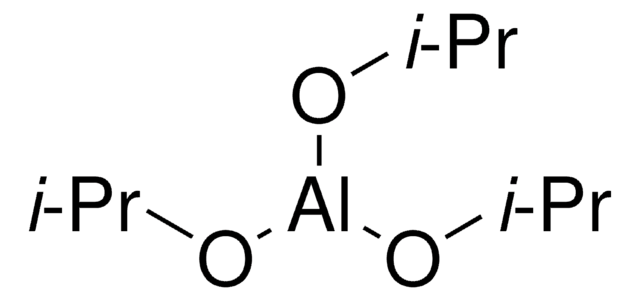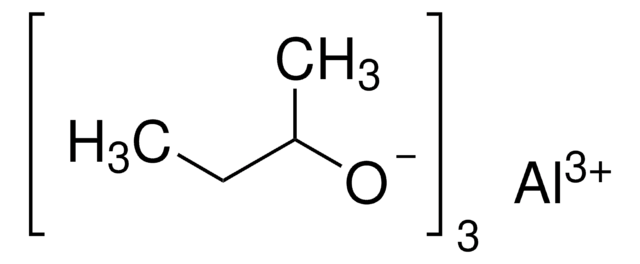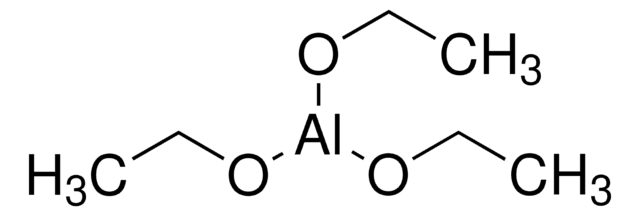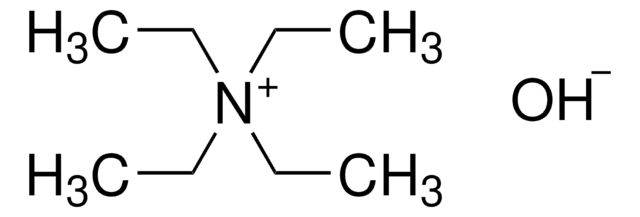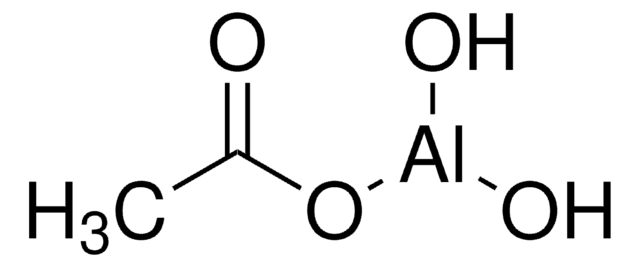229407
Aluminum isopropoxide
≥99.99% trace metals basis
Synonym(s):
AIP, Aluminum isopropylate, Aluminum triisopropoxide
About This Item
Recommended Products
Quality Level
Assay
≥99.99% trace metals basis
form
powder and chunks
solid
reaction suitability
core: aluminum
reagent type: catalyst
mp
128-133 °C (lit.)
density
1.035 g/mL at 25 °C (lit.)
SMILES string
CC(C)O[Al](OC(C)C)OC(C)C
InChI
1S/3C3H7O.Al/c3*1-3(2)4;/h3*3H,1-2H3;/q3*-1;+3
InChI key
SMZOGRDCAXLAAR-UHFFFAOYSA-N
Looking for similar products? Visit Product Comparison Guide
General description
Application
- Sol-gel precursor to synthesize ZnAl2O4 powders for transparent ceramics.
- Precursor material for the fabrication of nanosized SAPO-34 zeolites with a 4-fold increase in catalytic lifetime and significantly increased selectivity.
- A starting material to prepare long-persistent luminescence materials for display devices and bioimaging.
- Coating material to fabricate electrodes for lithium-ion batteries to enhance cycling stability and performance.
- A catalyst for alkylation of resorcinol with camphene.
Signal Word
Danger
Hazard Statements
Precautionary Statements
Hazard Classifications
Flam. Sol. 1
Storage Class Code
4.1B - Flammable solid hazardous materials
WGK
WGK 1
Flash Point(F)
60.8 °F - closed cup
Flash Point(C)
16 °C - closed cup
Personal Protective Equipment
Choose from one of the most recent versions:
Already Own This Product?
Find documentation for the products that you have recently purchased in the Document Library.
Customers Also Viewed
Articles
Advances in materials have often been led by the development of new synthetic methods that provide control over size, morphology and structure.
Advances in materials have often been led by the development of new synthetic methods that provide control over size, morphology and structure. The preparation of materials in a scalable and continuous manner is critical when development moves beyond lab-scale quantities.
White solid-state light can be generated using three different approaches: By employing three diodes that emit red, green and blue light respectively, by using a near-UV LED that excites several phosphors that emit over the complete spectral range, or the third, most widely used alternative entailing down-conversion of a portion of blue LED light to longer wavelengths in such a manner that white light emerges.
Spectral conversion for solar cells is an emerging concept in the field of photovoltaics, and it has the potential to increase significantly the efficiency of solar cells. Lanthanide ions are ideal candidates for spectral conversion, due to their high luminescence efficiencies and rich energy level structure that allows for great flexibility in the upconversion and downconversion of photons in a wide spectral region (NIR-VIS-UV).
Our team of scientists has experience in all areas of research including Life Science, Material Science, Chemical Synthesis, Chromatography, Analytical and many others.
Contact Technical Service